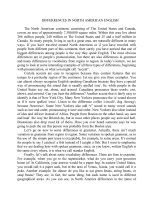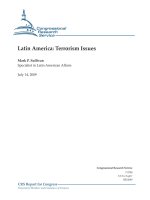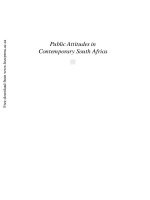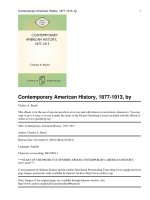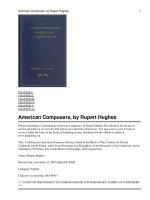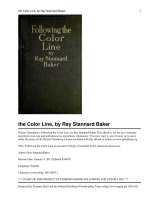hollywood utopia ecology in contemporary american cinema
Bạn đang xem bản rút gọn của tài liệu. Xem và tải ngay bản đầy đủ của tài liệu tại đây (2.04 MB, 272 trang )
Ecology in Contemporary American Cinema
Pat Brereton
Pat Brereton Hollywood Utopia
Utopianism, alongside its more prevalent dystopian
opposite, together with ecological study has
become a magnet for interdisciplinary research
and is used extensively to examine the most
influential global medium of all time.
This book applies a range of interdisciplinary
strategies to trace the evolution of ecological
representations in Hollywood film from the 1950s
to the present. Such a study has not been done on
this scale before. Many popular science fiction,
Westerns, nature and road movies are extensively
analysed, while privileging particular ecological
moments of sublime expression often dramatized
in the closing moments of these films.
Contents include:
• Hollywood Utopia: Ecology and Contempoary American
•
Cinema
• Nature Film and Ecology: Westerns, Landscape and Road
•
Movies
• Conspiracy Thrillers and Science Fiction: 1950s to1990s
• Postmodernist Science Fiction Films and Ecology
This book offers an intriguing and ambitious prospect: an
attempt to unearth the emergence of an ecologically-based
worldview pervading at least Western consciousness. The
author adopts a Raymond Williams-style approach to this
project, engaging in deep textual analysis of the Hollywood
blockbuster with a view to identifying whether those projects
are implicitly informed by some kind of subliminal eco-
consciousness.
(Dr. Roddy Flynn, Dublin City University)
intellect
www.intellectbooks.com
9 781841 501178
ISBN 1-84150-117-4
DDrr PPaatt BB
rreerreettoonn
is Chair of
the B.Sc. in Multimedia,
and a Lecturer in Film and
Media Studies at Dublin
City University.
intellect
“ Its clarity, its reach, its
honesty and its originality should
ensure this book a place on the
shelves of any media scholar and
many Green activists.”
TeAM
YYePG
Digitally signed by TeAM YYePG
DN: cn=TeAM YYePG, c=US,
o=TeAM YYePG, ou=TeAM
YYePG, email=
Reason: I attest to the accuracy
and integrity of this document
Date: 2005.07.07 14:57:22
+08'00'
Ecology in Contemporary American Cinema
Pat Brereton
Pat Brereton Hollywood Utopia
Utopianism, alongside its more prevalent dystopian
opposite, together with ecological study has
become a magnet for interdisciplinary research
and is used extensively to examine the most
influential global medium of all time.
This book applies a range of interdisciplinary
strategies to trace the evolution of ecological
representations in Hollywood film from the 1950s
to the present. Such a study has not been done on
this scale before. Many popular science fiction,
Westerns, nature and road movies are extensively
analysed, while privileging particular ecological
moments of sublime expression often dramatized
in the closing moments of these films.
Contents include:
• Hollywood Utopia: Ecology and Contempoary American
•
Cinema
• Nature Film and Ecology: Westerns, Landscape and Road
•
Movies
• Conspiracy Thrillers and Science Fiction: 1950s to1990s
• Postmodernist Science Fiction Films and Ecology
This book offers an intriguing and ambitious prospect: an
attempt to unearth the emergence of an ecologically-based
worldview pervading at least Western consciousness. The
author adopts a Raymond Williams-style approach to this
project, engaging in deep textual analysis of the Hollywood
blockbuster with a view to identifying whether those projects
are implicitly informed by some kind of subliminal eco-
consciousness.
(Dr. Roddy Flynn, Dublin City University)
intellect
www.intellectbooks.com
9 781841 501178
ISBN 1-84150-117-4
DDrr PPaatt BB
rreerreettoonn
is Chair of
the B.Sc. in Multimedia,
and a Lecturer in Film and
Media Studies at Dublin
City University.
intellect
“ Its clarity, its reach, its
honesty and its originality should
ensure this book a place on the
shelves of any media scholar and
many Green activists.”
The fruit of years of painstaking study, Pat Brereton's Hollywood Utopia is a
landmark in the emerging field of ecological media criticism. The more urban
human societies become, the more our media reflect upon the landscapes, the
animals and the fragile unities of our planet. Of no media formation is this more
true than of Hollywood, as Brereton argues in this meticulously researched and
carefully organised work. Far from trashing the planet, Hollywood films have,
Brereton claims, a tradition stretching back to the 1950s of care and concern for
humanity estranged from its roots, and a world at risk of destruction. Through
innovative analyses of Jurassic Park, Easy Rider, Thelma and Louise, Star Trek,
Terminator 2 and Blade Runner among countless older and newer films, Brereton
traces a utopianism often overlooked in traditional film criticism. Not only films
with explicitly Green agendas like Emerald Forest and Medicine Man, but in films
noted for far different qualities exhibit the saving grace of nature. Films like
Dances With Wolves or the towering spectacle of the tornado's heart in Twister
provide grist for an original and far-reaching account of the place of nature in
contemporary popular cinema. Dissent and disorder emerge in science fiction
films of the 1950s and blockbusters of the early 21st century. The book traces
complex negotiations with the meanings of nature and humananity's place in it
through costume dramas and high-tech special effects bonanzas, always with an
eye to the telling contradiction and the emergence of a generalised and liberal but
nonetheless impressive and perhaps heartfelt need to restore the bonds that have
been sundered between humans and their environment. To these analyses
Brereton adds a powerful and persuasive thesis concerning the spatial concerns of
contemporary Hollywood, a thesis that leads him through a broad overview of the
literature of green cultural studies and postmodernism. Throughout, Brereton
manages an easy, graceful prose to immense purpose. Its clarity, its reach, its
honesty and its originality should ensure this book a place on the shelves of any
media scholar and many Green activists, The ultimate optimism of its case is a
challenge to other critics to write for makers and audiences who want more from
cinema, both the cinema we have and the cinema we may yet make in the new
century.
(Sean Cubitt, University of Waikato, New Zealand)
Hollywoodutopialayout 20/10/04 4:54 pm Page 1
Hollywoodutopialayout 20/10/04 4:54 pm Page 2
Hollywood Utopia
Ecology in Contemporary American Cinema
Pat Brereton
Hollywoodutopialayout 20/10/04 4:54 pm Page 3
First Published in the UK in 2005 by
Intellect Books, PO Box 862, Bristol BS99 1DE, UK
First Published in the USA in 2005 by
Intellect Books, ISBS, 920 NE 58th Ave. Suite 300, Portland, Oregon 97213-3786, USA
Copyright ©2005 Intellect Ltd
All rights reserved. No part of this publication may be reproduced, stored in a retrieval system, or
transmitted, in any form or by any means, electronic, mechanical, photocopying, recording, or
otherwise, without written permission.
A catalogue record for this book is available from the British Library
Electronic ISBN 1-84150-912-4 / ISBN 1-84150117-4
Cover Design: Gabriel Solomons
Copy Editor: Wendi Momen
4
Hollywood Utopia
Hollywoodutopialayout 20/10/04 4:54 pm Page 4
Contents
7 ACKNOWLEDGEMENTS
9 FILMOGRAPHY
11 1. HOLLYWOOD UTOPIA: ECOLOGY
AND CONTEMPORARY AMERICAN
CINEMA
51 2. NATURE FILM AND ECOLOGY
91 3. WESTERNS, LANDSCAPE AND
ROAD MOVIES
139 4. CONSPIRACY THRILLERS AND
SCIENCE FICTION: 1950s TO
1990s
185 5. POSTMODERNIST SCIENCE FICTION
FILMS AND ECOLOGY
233 CONCLUSION
241 BIBLIOGRAPHY
259 GLOSSARY OF TERMS
Contents 5
Hollywoodutopialayout 20/10/04 4:54 pm Page 5
Hollywoodutopialayout 20/10/04 4:54 pm Page 6
ACKNOWLEDGEMENTS
I would like to thank media staff at my previous university in Luton as well as in
DCU for their assistance and encouragement. Other readers who helped in various
ways include Nick Heffernan, Peter Brooker, Christine Geraghty and Steve Neale.
Finally I wish to thank Angela and my family for their support over the many years
it took to complete this project.
Acknowledgements 7
Hollywoodutopialayout 20/10/04 4:54 pm Page 7
Hollywoodutopialayout 20/10/04 4:54 pm Page 8
SELECT FILMOGRAPHY
Andromeda Strain (1970) Robert Wise
Alien Resurrection (1997) Jean-Pierre Jeunet
Blade Runner (1982) Ridley Scott
Blade Runner: The Director's Cut (1991) Ridley Scott
Contact (1997) Robert Zemeckis
Dances with Wolves (1990) Kevin Costner
Dances with Wolves - Special Edition (1991) Kevin Costner
Dark City (1998) Alex Proyas
Easy Rider (1969) Denis Hopper
Emerald Forest (1985) John Boorman
Endangered Species (1982) Alan Rudolph
Fifth Element, The (1997) Luc Besson
Grand Canyon (1991) Lawrence Kasdan
Incredible Shrinking Man (The) (1957) Jack Arnold
Invasion of the Body Snatchers (1956) Don Siegel
Jaws (1975) Steven Spielberg
Jurassic Park (1993) Steven Spielberg
Last of the Mohicans (1992) Michael Mann
Logan's Run (1976) Michael Anderson
Lost World, The: Jurassic Park (1997) Steven Spielberg
Filmography 9
Hollywoodutopialayout 20/10/04 4:54 pm Page 9
Medicine Man, The (1992) John McTiernan
Men in Black (1997) Barry Sonnenfeld
Safe (1995) Todd Haynes
Searchers, The (1956) John Ford
Soylent Green (1973) Richard Fleischer
Star Trek: First Contact (1996) Jonathan Frakes
Straight Story, The (1999) David Lynch
Terminator (1984) James Cameron
Terminator 2: Judgement Day (1991) James Cameron
Thelma and Louise (1991) Ridley Scott
Them(1954) Gordon Douglas
Titanic (1997) James Cameron
Twister (1996) Jan De Bont
Waterworld (1995) Kevin Reynolds
Yearling, The (1946) Clarence Brown
10 Hollywood Utopia
Hollywoodutopialayout 20/10/04 4:54 pm Page 10
1 HOLLYWOOD UTOPIA: ECOLOGY AND
CONTEMPORARY AMERICAN CINEMA
Prologue
Ecology has become a new, all-inclusive, yet often contradictory meta-narrative
1
,
which this book will show to have been clearly present within Hollywood film since
the 1950s. This study focuses particularly on feel-good films whose therapeutic
character often leads to their being dismissed as ideologically regressive. By
concentrating on narrative closure and especially the way space is used to
foreground and dramatise the sublime pleasure of nature, Hollywood cinema can
be seen to have within it a ‘certain tendency’
2
that dramatises core ecological values
and ideas.
The study is committed to a strategy of building bridges and creating cross-
connections between film and other disciplines. In particular, the investigation
draws on Geography (space/place, tourism and so on), Philosophy (aesthetics,
ethics and ontological debates), Anthropology, Feminism and Cultural Studies,
while maintaining close contact with the traditional literary and historical
disciplines.
In the light of this cross-disciplinary approach, the first section of this introductory
chapter sets the scene for an ecological investigation, drawing on a wide range of
ideas and historical contexts, while the second section has a narrower focus,
clarifying a methodology for film analysis to be used throughout the study. Within
many blockbuster films, the evocation of nature and sublime spectacle
3
helps to
dramatise contemporary ecological issues and debates. Filmic time and space is
dramatised, often above and beyond strict narrative requirements, and serves,
whether accidentally or not, to reconnect audiences with their inclusive eco-
system.
As Bryan Norton puts it, environmentalism needs to educate the public ‘to see
problems from a synoptic, contextual perspective’ (Norton 1991: xi). In this
respect, Hollywood films can be seen as exemplifying, and often actually
promoting, this loosely educational and ethical agenda, particularly through the use
of ecological/mythic expression, evidenced in a range of narrative closures.
1 Hollywood Utopia 11
Hollywoodutopialayout 20/10/04 4:54 pm Page 11
Introduction
The primary justification for this study is the dearth of analysis of the utopian
ecological themes which pervade mainstream Hollywood cinema. There continues
to be a preoccupation with narratology in Film studies, which often avoids the
formal exploration of space. Coupled with this is the predominately negative
ideological critique of Hollywood film, with many cultural histories predicating
their analysis on Fredric Jameson’s view that ‘mass culture’ harmonises social
conflicts, contemporary fears and utopian hopes and (more contentiously)
attempts to effect ideological containment and reassurance. Relatively little
academic effort is given over to understanding and appreciating rather than
dismissing the utopian spatial aesthetic that permeates Hollywood film. This
phenomenon will be examined most particularly through a close reading of closure
in a range of Hollywood films from the 1950s to the present day, which can privilege
a ‘progressive’ conception of nature and ecology generally.
In his dictionary of ‘green’ terms, John Button defines ecology and the growth of
eco-politics as
a set of beliefs and a concomitant lifestyle that stress the importance of respect for
the earth and all its inhabitants, using only what resources are necessary and appro-
priate, acknowledging the rights of all forms of life and recognising that all that
exists is part of one interconnected whole
(Button 1988: 190).
The very idea of being ‘green’ only came into popular consciousness in the late
1970s, though since the 1950s ‘green’ has been used as a qualifier for
environmental projects like the ‘green front’, a tree planting campaign popularised
in America. The minimum criteria includes a reverence for the earth and all its
creatures but also, some radical greens would argue, a concomitant strategy
encompassing a willingness to share the world's wealth among all its peoples.
Prosperity can be achieved through ‘sustainable alternatives’ together with an
emphasis on self-reliance and decentralised communities, as opposed to the rat-
race of economic growth (see Porritt 1984).
While the ‘ideological’ analytical strategy, focusing on power inequalities across
class, gender and race boundaries, continues to preoccupy critical analysis of
Hollywood cinema, there is little if any critical engagement with the more all-
encompassing phenomenon of ecology. Yet, if so-called ecological readings are to
remain critical and avoid degenerating into endorsing ‘naive’ polemics, they must
explicitly foreground a variety of interpretations and perspectives, which question
any universal utopian project.
12 Hollywood Utopia
Hollywoodutopialayout 20/10/04 4:54 pm Page 12
To anchor this approach, notions of visual excess specifically drawn from feminist
studies of melodrama illustrating a breakdown in ‘conventional’ patriarchal
readings of film will be applied. By interrogating the over-determination of visual
excess in films by Douglas Sirk from the 1950s, for instance, with their accentuated
use of deep colours, together with heightened styles of acting, critics like Christine
Gledhill (Gledhill 1991) explored how such films helped to sustain a mise-en-
scène which stays with the audience long after the ‘tagged-on’ conformist closures.
This critical position articulates how excessive and overdetermined stylistic
devices serve to rupture and critique normative ideological readings, while also
helping to produce a more ‘progressive’ representation of feminist values. This
radical notion of visual excess will be reapplied, through an analysis of the narrative
resolutions of a range of Hollywood blockbuster films, to expose their latent
predisposition to excessively dramatise an ecological agenda.
Apparently unmediated and excessive representations of nature and landscape are
consciously foregrounded in many Hollywood films discussed in this book. In
particular, the film-time and space given over to this explicit form of unmediated
evocations of eco-nature help to dramatise and encourage raw nature to speak
directly to audiences, together with their protagonists, who finally find sanctuary
from particular environmental problems. This expression of therapeutic sanctuary
is often valorised over and above the strict narrative requirements of the text
through, for instance, framing, narrative point-of-view and shot length. Rather
than merely serving as a romantic backdrop or a narrative deus-ex-machina, these
evocations of eco-nature become self-consciously foregrounded and consequently
help to promote an ecological meta-narrative, connecting humans with their
environment.
Together with the visual aesthetic, the protagonists in the films discussed will also
be shown to embody various forms of ecological agency. This can be highlighted
through the evolution within mainstream Hollywood cinema of what can be typified
as a white, liberal-humanist, middle-class, ecological agenda across a range of
genres whose filmic agency in turn serves to reflect mainstream attitudes, values
and beliefs embedded in the ecology movement generally. This positive trajectory
is at odds, however, with the influential criticism of Christopher Lasch, who
notices a similar ‘hunger for a therapeutic sensibility’ but dismisses the impulse
owing to its complicity with the normlessness of ‘narcissistic American culture’
(Lasch 1978: 7).
Titanic
A recent blockbuster success story like Titanic (1998) is helpful in signalling many
of the often abstract preoccupations raised in this study. While Titanic appears, at
the outset at least, to have very little to do with ecology per se, it can nevertheless
1 Hollywood Utopia 13
Hollywoodutopialayout 20/10/04 4:54 pm Page 13
be read using these lenses. Especially when interpreted in terms of myth, together
with its engagement with textual excess and spectacle, the film provides a
provocative forum for articulating an ecological agenda.
The most common question critics address in relation to Titanic is why such an
‘old-fashioned’ film has become so commercially successful. Gilbert Adair
explains its fascination in terms of myth:
In the north Atlantic on 14th April 1912 at 11.40 pm, an immovable object met an
irresistible force, a state of the art Goliath was felled by a State-of-the-Nature David,
and our love affair with the Titanic was born
(Adair 1997: 223).
But why specifically do audiences want to experience (and re-experience) the
visceral sensation of a ship going down in all its awesome horror and observe its
passengers drown or freeze to death, especially while the heroine recounts her
personal epic and fulfils her destiny with her dead lover by sending the most
expensive diamond back to the bottom of the sea. A straightforward ideological
reading would critique the film's apparent romantic renunciation of materialism in
favour of ‘love’,
4
which consequently problematises its feel-good, utopian
expression.
However, adapting Adair's idea, one could also argue that mythical harmony, which
can be translated into the language of deep ecology, has also been restored by the
narrative. Audiences and protagonists experience how the past cannot always be
successfully salvaged for financial profit, in spite of advanced technology.
Conspicuous consumption is effectively critiqued when the most authentically
evidenced valuables are destroyed and slowly disappear as the ship succumbs to the
pull of the sea. Many of the films to be discussed similarly explore how primal
elemental forces of nature finally provide a renewed form of balance within the
narrative and become potent metaphors for a renewed expression of eco-praxis.
Extended moments of almost Gothic visual excess, often expressed through long
static takes of a sublime nature that help resolve the narrative, also serve as an
effective cautionary tale for audiences ruled by materialist values. Thomas Berry,
for example, reads Titanic as a ‘parable’ of humanity's ‘over-confidence’ when, even
in dire situations, ‘we often do not have the energy required to alter our way of
acting on the scale that is required’ (Berry 1988: 210).
Speed, movement and action remain synonymous with the myth of America itself.
This is very much evidenced by the popular male lead, Leonardo DiCaprio,
standing on the prow of the fantasy ship with his hands outstretched like a
14 Hollywood Utopia
Hollywoodutopialayout 20/10/04 4:54 pm Page 14
benevolent deity as the camera triumphantly tracks down its length. Audiences at
the end of the century appeared to crave such spectacle, as the allegory of this
terrible disaster of a sinking ship testifies.
5
Nature, in the form of solid frozen
water and its equally potent liquid form, will inevitably claim its human victims.
Metaphorically, the humans become sacrificial victims for the sins of capitalism,
which tries to ignore the innate potency of nature.
While this film cannot easily be described as a conventional ecological text,
nonetheless it does create a form of excess, which can be used to promote an
ecological reading. This is embodied in the ship itself, which becomes the
representational embodiment of nineteenth-century western industrial capitalism
and is affirmed by many audiences’ response to it as a primary focus of
identification and attraction. As one reviewer concludes, at the end of the
millennium, ‘what grandeur and pathos the film possesses belongs to the mythic
story of the shipwreck itself’ (Arroyo 1998: 16).
Thus the (pre)modernist scientific certainties together with the hierarchical social
controls, which include a fatal dismissal of the potency of nature, symbolically
represented by the intractable icebergs, are finally called to account. From a textual
point of view, this ‘shallow’ representational narrative device remains successful, if
only on a mythic romantic level. As in the hero's intertextual link with his previous
film role in Romeo and Juliet, love conquers all, even death. James Cameron, the
director, who will be discussed in detail later regarding the development of cyborgs
in Terminator (1984) and other films, has succeeded in creating what appear at first
sight to be mythic agents who can embody audiences’ fantasies, needs and fears for
a new millennium, by indulging and legitimising a renewed form of nostalgia for
nature. This overblown text, which comfortably fits into the natural disaster sub-
genre, is not necessarily designed to be strong on praxis through the resolution of
problems, yet can be read as provocative, as its narrative implications prompt a
renewed symbiosis between ‘eco-sapiens’ and their environment.
At the outset, the most overt critique embedded in the text centres on class. But
most critics agree that it presents a simplistic evocation of class politics, with its
working classes more easily enjoying themselves yet trapped in the bowels of the
ship, in contrast to their stuffy counterparts ‘upstairs’. Audiences are clearly
positioned to identify with the jouissance of the lower orders, yet invited at the
same time to wallow in the luxuriant pleasures and material benefits of the wealthy.
Nevertheless, because ecological concepts are not as clear-cut as ideological power
divisions like class, Titanic can at least question outmoded notions of rationality
and affirm a more eco-centred consciousness.
By representing and establishing holistic if enigmatic ecological tropes, Titanic
begins to extend a nascent thematic and aesthetic lexicon which often
1 Hollywood Utopia 15
Hollywoodutopialayout 20/10/04 4:54 pm Page 15
unconsciously expresses, even legitimises, core ecological precepts, especially
ecologism which promotes the principle of sustainability. Titanic suggests humans
have to be educated to consume less and to produce more self-sufficiently to satisfy
their basic needs.
Nature and the Roots of Ecology
'Ecologism', argues Andrew Dobson, makes
the Earth as physical object the very foundation-stone of its intellectual edifice,
arguing that its finitude is the basic reason why infinite population and economic
growth are impossible and why consequently, profound changes to our social and
political behaviour need to take place
(cited in Talshir 1998: 13).
Dobson reconstructs ecologism as a comprehensive ideology in which the
philosophical basis (limits to growth), the ethical perspective (ecocentrism), the
social vision (a sustainable society) and the political strategy (radical
transformation, not reformism) provide a coherent and cohesive ideology (ibid.:
15). Ecologism most certainly validates the non-sustainability of resources together
with its central premise of human interconnectivity with the rest of the biotic
community and even with the cosmos. The abiding strength of these ‘holistic’
approaches is that they regard the interrelationship of environmental variables as a
primary concern which is ‘explicitly anti-reductionist’ (Sklair 1994: 126). This
holistic utopian, even spiritual, perspective will be illustrated in detail in
subsequent chapters, most notably through a comparative study of The Incredible
Shrinking Man (1957) and Contact (1997).
But to begin this process of analysis, a working definition of ecological utopianism
needs to be outlined by tracing its historical, cultural and theoretical antecedents.
Particular emphasis will be placed on the divisions between ‘deep’ and ‘light’
(shallow) ecology which is also reflected in the tensions inherent in ideological
critiques and the debates about utopianism to be explored later. Finally, before an
evolving prototype for the textual analysis of film can be considered, a survey of
philosophical/ political positions will also be used to illustrate critical positions
emerging from ecology. In many ways, ecology has become the most dominant and
inclusive discourse of the late twentieth century.
Most cultural critics generally begin with the premise that ‘our representation of
nature’ usually reveals as much, if not more, about our inner fears and desires than
about the environment.
6
Nevertheless the two attributes can be regarded as
16 Hollywood Utopia
Hollywoodutopialayout 20/10/04 4:54 pm Page 16
coterminous, since our inner fears and desires often reflect or at least constitute in
large part the ‘external’ environment.
Utopian (and dystopian) fantasies remain pervasive across popular film culture,
most explicitly within the science fiction genre, with the concept of nature often
acquiring more universal and less contentiously nationalistic connotations (as
displayed most notoriously within German Nazism). However, David Pepper's wish
to combine ‘red’ and ‘green’ ideologies to create a new ‘third way’ is more often
obscured and seldom reconciled within Hollywood cinema, as signalled in Titanic.
But these fantasies, which often encompass a deep ecological framework, more
easily pervade the explicit nature genres explored in Chapter 2, as well as westerns,
road movies and science fiction films, discussed in subsequent chapters. This
study cannot limit itself to unpacking an ideological framework, however, since the
ecological predisposition evidenced through textual analysis often seeks to
transcend the particularities of ideological spatio-temporal power conflicts and
affirm a more universal ecological framework. The resultant trend of using the
often contradictory therapeutic romantic power of nature to help audiences
overcome the distresses of modern living is explored most specifically in the
following chapter. These therapeutic narratives have possibly become more prolific
as western society has acquired a greater appreciation of core ecological debates
together with awareness of the issues involved. This in turn has stimulated the
need and the search for new forms of human agency to engage with and promote
ecological utopianism.
Philosophical Myths of Nature
Nature, like Utopianism, can nonetheless mean almost anything one wishes, a
particular danger when the term is co-opted for direct political use.
7
Norton, while
accepting these consequences, nevertheless states that the:
rules governing our treatment of nature are guided neither by the authority of God
nor by a priori, precultural moral norms such as rights of natural objects.
Environmentalism has been forced to recognise that we must struggle to articulate
limits on acceptable behaviour by learning more and more about how we affect, and
are affected by our environmental context
(Norton 1991: 253).
His edict, cited above, that environmentalists must educate the public ‘to see
problems from a synoptic, contextual perspective’ (ibid.: 250-3) must be applied to
Hollywood films in this investigation also. These ecological manifestations will be
historically mapped through various readings, beginning with 1950s science fiction
1 Hollywood Utopia 17
Hollywoodutopialayout 20/10/04 4:54 pm Page 17
films and concluding with recent commercially successful science fiction texts
which explicitly focus on a range of global ecological fears.
As a new millennium approached, many critics pointed out that globally inclusive
myths became even more necessary, whereas others suggested that ‘the psychic
and social structures in which we live, have become profoundly anti-ecological,
unhealthy and destructive’. Consequently, there appears to be a need for ‘new
forms, (re)emphasising our essential interconnectedness rather than our
separateness, evoking the feeling of belonging to each other’ (Gablik 1991: 5).
‘Man lives in a progressive, expressive, non-repetitive time; [whereas] ecology is
the science of cyclical repetition’ (Gunter in Glotfelty 1996: 54). Hollywood mythic
texts serve to connect these contrasting time frameworks. The British philosopher
Kate Soper (Soper 1995) reiterates how even Marx recognised the civilising
impulse implicit in mythic expression and its ‘escape’ from encrusted modes of
rationalisation. The central problem for modern-day human agency remains how
to avoid putting too much stress on the environment from an apparently
unreconcilable desire for fulfilled individual lives.
Soper concludes her polemic:
Rather than becoming more awe-struck by nature, we need perhaps to become more
stricken by the ways in which our dependency upon its resources involves us irre-
deemably in certain forms of detachment from it. To get ‘closer’ to nature, in a sense
[is] to experience more anxiety about all those ways in which we cannot finally iden-
tify with it, not it with us. But in that very process, of course, we could also be trans-
forming our sense of human identity
(Soper 1995: 278).
One of the ways of trying to understand this ethical relationship with nature has
been through ecological frameworks and most notably through the application of
the Gaia thesis.
Gaia and Eco-ethics
The Gaia thesis, like Aldo Leopold's seminal ‘land ethic’, affirms that the
biosphere
8
together with its atmospheric environment forms a single entity or
natural system. Gaia is regarded not only as an entity but a process which, like
evolution, can be regarded as a goal directed one. Nature, therefore, is seen as
neither ‘omniscient nor omnipotent’ (Goldsmith in Jencks 1992: 399-408) since
life processes can go wrong, a scenario depicted in Jurassic Park, which will be
discussed in detail in the following chapter.
18 Hollywood Utopia
Hollywoodutopialayout 20/10/04 4:54 pm Page 18
If the world is recognised as one self-regulating system, then progress through
competition logically becomes fundamentally anti-evolutionary and co-operation
becomes ‘the true evolutionary strategy’ (Goldsmith in Jencks 1992: 399). Gaia,
the Greek deity who brought forth the earth from chaos (or the void), symbolises,
for both feminists and the environmental movement in particular, a potentially
powerful force for progressive evolution. Gaia inspires a sense of the earth as a
holistic living organism, which for many twentieth-century environmentalists
evokes a new earth ethic.
9
Both feminist spirituality and scientific theory recast
Gaia as a compelling signifier for a new understanding of, and reverence for, life on
earth, while also becoming a forceful metaphor for the new postmodern age.
Yet problems remain with this conception, since it carries a cultural baggage that
could undercut its inspirational power, in particular the understanding of Gaia
primarily as a ‘maternal mother’ or even a ‘super servant’ who will keep the planet
‘clean’ for humans. If Gaia is in fact a ‘self-regulating homeostatic system, then
“she” can correct problems caused by humans or even find humans expendable’
(Merchant 1995: xx-xxi) - which does not equate with the benevolent image of a
nurturing mother or even a servant.
The ecological imperative seeks to reiterate a dominant global and holistic ethic for
all sentient beings on the planet. Leopold was possibly the first person to articulate
this green ethic by declaring: ‘a thing is right when it tends to preserve the
integrity, stability and beauty of the biotic community. It is wrong when it tends
otherwise’ (Leopold 1947: 224-5).
This apparently simple if evocative mantra of primary ‘natural’ ethics, becomes
very appealing within a world which has become for many ‘fractured and
incoherent’ (Bunce 1994: 49).
10
As Frederick Ferre reiterates, ‘we need to learn in
new modes of ethical holism, what organic interconnectedness means for human
persons’(in Attfield and Belsey 1994: 237). Utopian Hollywood films which tend to
endorse these assumptions serve this project extremely well.
11
Paul Taylor effectively consolidates environmental ethics as including:
- An ultimate moral attitude of ‘respect for nature’;
- A belief system, which he calls ‘the biocentric outlook’;
- A set of rules of duty that express ‘the attitude of respect’ (Taylor in Gruen 1994:
43).
1 Hollywood Utopia 19
Hollywoodutopialayout 20/10/04 4:54 pm Page 19
Taylor goes on to suggest that this produces several basic rules of conduct:
1) ‘Rule of Non-maleficence’ - prohibits harmful and destructive acts done by
moral agents.
2) ‘Rule of Non-interference’ - to refrain from placing restrictions on the freedom
of individual organisms and requiring a general ‘hands-off’ policy with regard to
whole eco-systems and biotic communities, as well as individual organisms.
3) ‘Rule of Fidelity’ - applies only to human conduct in relation to individual
animals that are in a wild state and are capable of being deceived or betrayed by
moral agents.
4) ‘Rule of Restitutive Justice’ - the duty to restore the balance of justice between
a moral agent and a moral subject when the subject has been wronged by the agent.
The first of these rules is implicit in most Hollywood narratives while the second
is most clearly detected within the science fiction genre. In particular the rule of
non-interference directly supports Roddenberry’s ‘Prime Directive’ in the Star
Trek franchise, to be discussed in Chapter 4. Issues like the rule of fidelity will be
specifically addressed through an analysis of more overtly thematic ‘light’ eco-texts
like John Boorman’s Emerald Forest (1985), while the rule of restitutive justice is
most explicitly discussed in relation to the Disney/Spielberg oeuvre. These
ecological and ethical guidelines remain central to this study and naturally become
more explicit in films when some ethical norm is called into question. These rules
are applied most extensively in later discussions of science fiction where extra-
terrestrial ecological systems serve to highlight the uniqueness of the earth’s
symbiotic life forces over and above human dominance.
In many cases, as the Gaia myth affirms, the earth can look after itself in spite of
humanity’s impotence and ignorance. This can, in turn, serve to question the
necessity of an ethical system, since it suggests that human agency is finally
unimportant within the greater macro-system. Within such a green evolutionary
utopianism there are many further anomalies which must be exposed and hopefully
re-evaluated. For instance, must ecologists solve the primary conflict inherent in
most utopian structures, namely the rights of individuals as opposed to the ‘ideal’
communal system? Or put another way, must ecology privilege the (organic, self-
regulating) ‘system’ at the expense of, or in opposition to, individual human
agency? The risk of legitimising a potentially totalitarian system, which reduces
individual expression to systematic homogeneity, remains ever present.
Another thorny anomaly linked to the above is the problem of how, if there is no
pre-defined hierarchical order, with ‘man’ at the apex, one can determine ‘human’
20 Hollywood Utopia
Hollywoodutopialayout 20/10/04 4:54 pm Page 20
value(s) outside of the multitude of conflicting biological ‘needs’ of various flora
and fauna within the earth’s eco system. Inherent contradictions such as those
indicated here remain ever present in the texts considered and can become
magnified by attempts to foreground an all-encompassing meta-narrative for
human behaviour, or even representing and privileging an ecological utopian ideal.
More often, however, a dystopian environment is foregrounded, particularly in
many of the science fiction narratives to be discussed in this book.
The central tenet of ecology as affirmed by many of the major ecological critics
embodies ‘harmony with nature’ together with the recognition of ‘finite resources’.
Everything else in this view is therefore either peripheral to, or at best ancillary to,
these all-inclusive affirmations. But there is often little agreement through the
large rainbow of ‘green supporters’ on the specific means, especially the priorities
and timescales, for achieving these ends. Simply looking for hope, through an
artificial development of holistic systems, can be a recipe for disaster.
Consequently there is an inherent danger of endorsing the trend of using the
therapeutic romantic representation of nature to help audiences overcome the
distresses of modern living, which has become prevalent in Hollywood and
designed to appeal to audiences across class, race and ideology. In spite of such
dangers and while it is critically easier to dismiss aspects that conform to this broad
therapeutic premise, it remains crucial to clarify and tie down how films promote
broadly utopian values. Meanings continually shift and slide within Hollywood
cinema.
As a relatively modern phenomenon, however, ecology remains a totalising concept,
which is inclusive rather than exclusive.
12
This naturally causes severe problems in
trying to create and maintain strict guidelines and terms of reference. As Tim
Unwin postulates, ‘it would be difficult to find a set of issues which symbolise more
vividly the torment of a way of life gone astray, which captures more exactly the
transformative urge propelling political and economic works’ than those raised by
modern ecology (cited in Norton 1991: 188). Furthermore, as Andre Gorz warns in
Ecology as Politics, environmentalism is continually being ‘commandeered’ by the
dominant groups in western society for their own ends. The forces of capitalism
are very capable of adapting an ‘environmental conscience’ to meet the needs of the
dominant culture (Gorz 1987: 114B30). Such contradictions and ambiguities must
be faced up to.
Utopianism versus Ideology
Utopianism can be broadly defined as the desire for a better way of living expressed
in the description of a different kind of society that makes possible an alternative
way of life. Utopianism has a long and distinguished pedigree and has informed
thinkers from the Frankfurt School to Ernst Bloch and Fredric Jameson.
13
The
1 Hollywood Utopia 21
Hollywoodutopialayout 20/10/04 4:54 pm Page 21
22 Hollywood Utopia
Frankfurt School critique of ideological domination which preoccupied much
academic debate over the last few decades provided a primary focus for beginning
to appreciate how ecology could be understood within this cultural context.
14
Having laid aside the working class as the agents of changing history, the Frankfurt
School had difficulty in finding an alternative locus of action. Herbert Marcuse,
especially, put his faith in youthful rebellion powered by ‘Eros’, a theme that will be
explored in the example of road movies like Easy Rider (1969). Youth culture could
aspire to throwing off the shackles of ideological repression and begin to
conceptualise new, more harmonious modes of living. Marcuse was possibly the
most optimistic of the Frankfurt School thinkers with regard to the potency of this
utopian impulse. He considered art as the socially sanctioned realm of fantasy and
the bearer of utopia. In The Aesthetic Dimension, he asserted, ‘Art cannot change
the world, but it can contribute to changing the consciences and drives of men and
women who change the world’ (Marcuse 1979: 32). His optimism lay in the belief
that the sheer power of truth revealed would transform consciousness and
ultimately create a ‘democratic public out of an inert mass’ (cited in Seidman 1994:
187).
Unlike Marcuse, Theodor W. Adorno was consistently more pessimistic, regarding
art as only offering glimpses of a utopia, which in any case was unobtainable (Bird
et al. 1993: 262).
15
Many earlier utopian visions were, in fact, not designed to
promote change at all and it is ‘only with the advent of progress and the belief in
some degree of human control over social organisation that the location of Utopia
in the future (coupled) with human action became a possibility’ (Levitas in Bird et
al. 1993: 259).
Ernst Bloch’s great work The Principle of Hope (translated into English in 1986)
asserts that radical cultural criticism should seek out those utopian moments,
those projections of a better world, which he claimed are found in a wide range of
texts. Bloch provides a systematic examination of the ways that daydreams, popular
culture, great literature, politics and social utopias, philosophy and religion -often
dismissed out of hand by some Marxist critics -contain emancipatory moments
which project visions of a better life that question the organisation and structure of
life under capitalism (or state socialism).
For Bloch, ideology was ‘Janus-faced’, since it simultaneously contained errors,
mystifications and techniques of manipulation and domination, while also
containing a utopian residue or surplus that can be used for social critique and to
advance political emancipation. Bloch believed that all ideological artefacts contain
expressions of desire which socialist theory and politics should heed in order to
provide programmes, which appeal to the deep-seated desires for a ‘better life’
within everyone. I would suggest that many Hollywood texts contain a surplus or
Hollywoodutopialayout 20/10/04 4:54 pm Page 22
